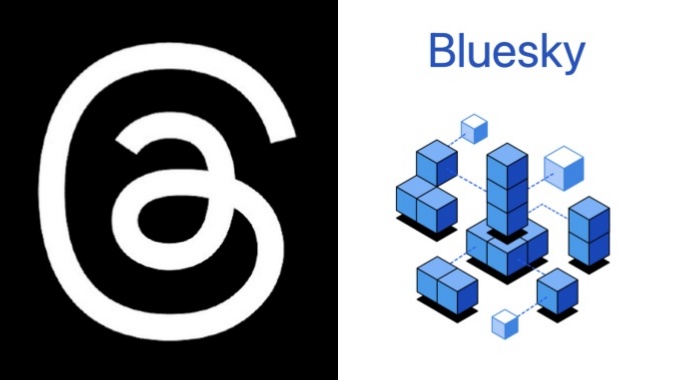Threads vs. Bluesky: Can There Be Two Twitter Replacements?
Images via Meta/Bluesky
We’ve spent the past year or so waiting to see which new social media platform might be able to replace Twitter — but could there actually be two “new Twitters” by the time the dust settles? Not to mention, of course, the lingering corpse of Twitter itself (if it’s still functional and solvent, ahem).
The future of the OG micro-blogging platform has never been more tenuous, with Elon Musk’s regime keeping Twitter seemingly on the knife’s edge of collapse (fresh off the rate limit fiasco that made the system effectively unusable for millions over the span of two days), with radical new policies and user-hostile changes rolling out at a near-monthly basis at this point.
Though some seem to like the direction Musk has taken Twitter (looking at you, Tesla fanboys and crypto scammers!), a whole lot of people are desperately looking for a port in the storm for a social network that can function in the same way as Twitter, just without the right-wing politics and chaos that Musk has started imprinting into the service’s DNA over the past year.
A whole lot of services have already popped up, ranging from the long-running open-source project Mastodon (which is arguably a bit too complicated for the average user), as well as up-starts like Hive Social and Post. But none of those have managed to truly capture the zeitgeist, though two more recent entries could have the pedigree to become the “new” Twitter.
Not surprisingly, you’ll probably recognize the folks behind them. Bluesky was created by original Twitter founder Jack Dorsey; while the newly launched Threads was developed by Meta and is linked to the company’s Instagram architecture. Both bring the experience and hype to actually (potentially) challenge Twitter.
So how do they stack up?
Threads
Meta has been developing its own text-based social network platform for a while now, but when Twitter melted down with the rate limit disaster, Mark Zuckerberg & Co. pushed up the app’s release date to capitalize on the chaos. Judging by the early reaction, the surprise launch was a smart move. The service amassed 70 million sign-ups two days after it went live, with users making more than 100 million posts (or “threads”).
Meta wisely leveraged its Instagram audience to make signing up a simple one-click process if you already had an Instagram account, and the company courted major brands and celebrities to get them posting on the app before launch, so a lot of the famous big names you might be used to seeing on Twitter were already on Threads from Day 1. It helped bring an air of buzz and legitimacy to the platform from the jump, though it also felt a bit too polished and branded, if that makes sense. But if Threads can attract even one-fourth of Instagram’s approximately 2 billion users, it could put it ahead of Twitter’s reported 420 million active users pretty quick. The stability of Meta also appears promising for advertisers looking to spend money on social media after plenty of major firms paused and pulled spending on Twitter due to Musk’s unpredictability.
But it’s not all great at Threads, especially for users accustomed to some of Twitter’s basic functions. Most importantly, there is no way to have a “follower-only feed,” meaning your main Threads feed is a mix of the folks you choose to follow, as well as posts recommended by the algorithm. Considering how much people generally hate the “For You” feed on Twitter, that could be a problem, though considering the product is an Instagram spinoff, the choice makes sense. For what it’s worth, the company says a follower-only feed is “on the list” of planned features. In actual use, the algorithm doesn’t seem too bad, with most of my personal feed in testing populated with posts from the people I already follow, and a mix of content and users that make sense within that ecosystem. But, it’s still not ideal.
There are also no direct messaging options available at launch, and with this being a Meta product, you’re obviously signing away some personal data privileges when you sign up to use the product. But if you’re already using Instagram, that might not be too big of a compromise. That Instagram connection does solve one of the biggest self-inflicted problems in Musk’s Twitter, though, with user and brand verification carrying over from Instagram. Instagram already has a verification process not unlike the old version of Twitter, where a checkmark actually means the person or brand is legitimate, and not that they’re simply willing to part with $8 per month for a checkmark. The verification process might need some tweaking at Threads (especially if they hope to attract the journalists and newsmakers who make up the small but mighty contingent of Twitter power users), but it’s a solid foundation to build on.
Bluesky Social
After leaving Twitter, Jack Dorsey turned his attention to taking another swing at a social network with Bluesky Social. The service is a decentralized social network that is still in an invite-only beta phase, though it has attracted close to a million or so users at this point as folks fight and claw for those invite codes to get in on the ground floor. It’s worth noting that user number could be higher (or much higher) now, as Bluesky has had to sporadically pause new sign-ups due to an influx of users jumping on as they ramp up infrastructure.
-

-

-

-

-

-

-

-

-

-

-

-

-

-

-

-

-

-

-

-

-

-

-

-

-

-

-

-

-

-

-

-

-

-

-

-

-

-

-

-








































